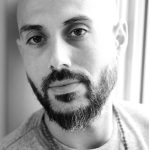Appears in the Spring 2016 Issue of The Wayfarer. Order a print or the full e-edition here»
The Contemplative Column by Theodore Richards
Watching/Seeing
Yet I also suspected that what I was seeing was but a part of the truth and perhaps not even the most important part; beneath these faces, these clothes, accents, rudenesses, was power and sorrow, both unadmitted, unrealized, the power of inventors, the sorrow of the disconnected.
—James Baldwin, Giovanni’s Room
As a matter of practice I try to limit my media consumption. Because my work requires me to spend time in front of screens—writing, social media, sending emails—I generally don’t spend much time watching the myriad videos that float around cyber space. Have you seen that video? I am often asked. And the answer is usually no. So I was late in seeing the video that showed LaQuan McDonald being killed. Or at least, late by today’s instant-or-it’s-old standards. There was a part of me that felt like watching the murder of a child was grotesque and obscene, and I’d seen enough and heard enough to know that his murder was brutal and unnecessary; but still another part felt like I should at least know what I was talking about in what was the central issue in the city I call home, Chicago. After all, there were protests in the streets; the mayor was under siege.
So I watched.
I’d seen other videos of police brutality, from the Rodney King beating that impacted my youth so profoundly to Oscar Grant’s murder at my train stop in Oakland. But this one was unparalleled in its brutality. I saw a boy, walking, then suddenly on the ground. I saw him twitch, scarcely moving, as bullet after bullet entered his body; I saw the pause, saw him defenseless and prone, probably already dead, and then saw the remaining bullets, each one from the officers gun—would he still be shooting if he hadn’t run out?—enter the boy’s body. 16 shots.
I realize then that seeing this video, and experiencing it as I did, was essential. I had to do it. I couldn’t look away.
But I also realized that many Americans are incapable of actually seeing what I saw. For the consumption of any medium—this is as true with a work of art as it is with something so crass as a police video—is interactive. The seer brings forth the video, interprets it, integrates it into an already-present narrative.
Many Americans, perhaps most, didn’t see a defenseless child being murdered by a man with a gun; they saw not a child, but a threat, a criminal, a “demon”, to borrow the words of Darren Wilson, the officer who killed Michael Brown in Ferguson. They couldn’t see it, even if they watched it.
The capacity to see this murder, to bear witness to it, to actually feel the suffering, is spiritual work. But the work isn’t done in merely looking at a death on a screen. The question is what can we actually do next. Is there anything I can do to prevent my own child from being gunned down like this?
A movement is happening. And it is not—let us be clear—because such violence is new. There is a clear line to link lynchings and police violence, slavery and mass incarceration. Race, and the injustices of the systems that have developed around the social construction of race, is deeply embedded in American society, to such an extent that Black people are forced to see it in every interaction and White people cannot see it at all. To a large extent, therefore, the Black Lives Matter movement and the fight against mass incarceration are movements to get people to see what, without the race-colored glasses that White people wear, is clear.
This is the spiritual practice of perception, something that is fundamental to many different traditions. The Greek word theoria is used to describe the “looking at” or “becoming aware of” the risen Christ. Mary didn’t simply see Jesus—she became aware of his presence because she had cultivated a particular state of mind. She could now know his rebirth in a deeper, more mystical way. And this awareness was her own rebirth, too. Theoria becomes contemplatio in Latin—contemplation in English.
A core concept in yoga practice is this notion of perception. The eradication of the distinction between seer and seen becomes part and parcel of advaita Vedanta, the nondual philosophy of Hinduism. Satya, the second of the five yamas, refers to “truth”, or seeing things as they truly are. Gandhi used this word to describe his work, satyagraha. He didn’t merely want to overthrow the British; Gandhi understood that his work required both Indian and British alike to see things as they really are.
Action
Most of us, no matter what we say, are walking in the dark, whistling in the dark. Nobody knows what is going to happen to him from one moment to the next, or how one will bear it. This is irreducible. And it’s true of everybody. Now, it is true that the nature of society is to create, among its citizens, an illusion of safety; but it is also absolutely true that the safety is always necessarily an illusion. Artists are here to disturb the peace.
—“An interview with James Baldwin” (1961)
It is hard to pause to contemplate anything when you feel like you are under siege. Many decent police officers have failed to do so, going on the defensive and blindly rationalizing anything their peers do. Some even have been involved in cover-ups.
This is true of the activist scene as well. In Chicago, in particular, there is an urgency that has led to a lack of reflection. Chicago is a competitive place. People defend their turf. Indeed, in this most American of cities, competition and fragmentation are so woven into the culture that they are barely perceived. I’ve tried to bring a holistic approach to the activist scene here, arguing for the need for contemplative practice and art, but the response, in general, has been that such things have no place in the movement.
It is easy to see why: religion has so often been a vehicle for conservative forces. It has promoted patriarchy and hierarchy. And one hears more about the insipid “prosperity gospel”, promoting Right Wing economic theories, from both New Age and Christian fundamentalists, than about Liberation Theology.
What activists would do well to learn, however, is that the real work is in getting people not merely to watch—people are watching stuff on screens all day!—but to see. And this cannot happen without deep internal work (contemplation) and without the re-imagining of narratives (art).
Most movements struggle with the fact that they exist within the system they seek to overturn. When today’s activists are fragmented and competitive, it is because they live in an individualistic and capitalist culture. There is also a sneaking Puritanism that arises in the activist scene, a subtle judgment of anyone who might be finding a bit of joy living in an unjust system. These things cannot be seen because we are immersed in them. It takes real work to overcome them.
So, to borrow some terminology again from our spiritual traditions, action may begin out of anger or necessity, but it must move into the realm of mindful action. And one must find a delicate balance between a focus on outcomes—of course, effectiveness is important—and a detachment from outcomes altogether. The process is important, too. This is the pathway from activism to sacred activism.
Sacred Activism
All roles are dangerous. The world tends to trap you in the role you play and it is always extremely hard to maintain a watchful, mocking distance between oneself as one appears to be and oneself as one actually is.
—James Baldwin, “The Black Boy Looks at the White Boy”, Esquire (May 1961)
What activists do understand, perhaps better than most religious communities, is that the world itself is sacred, and we honor it by working at making it better. At the same time, the activist community has to realize that there is work to do at their own capacity to perceive. Contemplative work. When they reject this work they show just how embedded they are in the system of alienation and fragmentation they seek to undermine. Too often, spiritual work is rejected because it is perceived as being oppositional to justice work—as if religion or spirituality were merely one thing. It is like, as Chimananda Ngozi Adichie says about literature when she is asked what a book is about: no work of literature, or any work of art, could be about one thing.
For example, just as religion has been vehicle for patriarchy, it also provides a pathway for the rediscovery of a more feminine sensibility. Moreover, religions often undermine the fragmented, individualistic ethos of Modernity. The interconnection of Buddhist cosmology or the communalism of indigenous cosmologies speak to a self that cannot be separated from anyone else. This allows us to see ourselves as part of an ecological whole and allows us to undermine that constructed concept of race. Only when White people begin to understand that the very notion of “whiteness” is a tool of oppression, only when white people stop seeing a murdered child as primarily black, as other, as opposed to a human being, will the violence stop.
Only when we see that we, in fact, are the murdered child, can we cultivate the compassion to stop the cycle of brutality and violence.
Indeed, a cosmology of interconnection helps us to perceive the connection between social justice and spirituality itself.
For the activist community, a greater challenge is in seeing that we also are the police who kill our children; we are Chicago mayor Rahm Emmanuel, whom many have accused of a cover-up. At the same time, we must practice the work of discernment: we don’t have to fall into wishy-washy platitudes; we can fiercely criticize the system even as we recognize we are a part of it. Dr King knew this, knew that fighting a system of oppression meant not only that one cannot allow the oppressed to succumb to hate, but also that in loving one’s oppressor one must also be fierce in one’s critique of that system.
16 Shots
I love America more than any other country in the world and, exactly for this reason, I insist on the right to criticize her perpetually.
—James Baldwin, Notes of a Native Son
And so, we’ve all got to see. This is the hard part. Laws are easy. Organizing is easy. Getting people to see the injustice of our system is hard. Getting people to watch the video, watch each bullet enter the boy’s body, and suffer—that’s hard.
 Theodore Richards is a novelist, philosopher, and educator, and is the director and founder of The Chicago Wisdom Project. He is the author of several books, most recently the novel The Conversions, and the recipient of numerous literary awards. He lives on the south side of Chicago with his wife and daughters. Visit www.theodorerichards.com
Theodore Richards is a novelist, philosopher, and educator, and is the director and founder of The Chicago Wisdom Project. He is the author of several books, most recently the novel The Conversions, and the recipient of numerous literary awards. He lives on the south side of Chicago with his wife and daughters. Visit www.theodorerichards.com
The Wayfarer is released biannually each spring and autumn. We offer approximately 60% of each issue free to the public on our website. If you find yourself inspired by what you read here and would like to enjoy a full issue, you have a few options.
Print Edition: Individual print editions starting at $8.99 are available in our bookstore. Each print edition is full-color, perfect bound and printed on paper with chain of custody certification from the Forest Stewardship Council, Sustainable Forestry Initiative, and the Program for the Endorsement of Forest Certification. • Our Shop»
Full e-Edition: Complete e-editions are also available in our bookstore. In mere minutes and for less than a cup of tea you can be downloading the full PDF to your computer or favorite device. • Our Shop»
Print Subscription: We offer subscriptions to the print edition. When you subscribe to the print edition, you also receive the e-edition free! With each release, we will send you your copy of the print edition while at the same time sending you a secure link via email for you to download your e-edition! • Learn More»
e-Edition Subscription: If you are just interested in receiving the e-Edition, a 1yr e-subscription is the right step for you. For only $2.99 you can receive 2 issues of The Wayfarer’s e-Edition. Each spring and autumn, you will wake up to find a fresh issue of the journal waiting in your inbox. Download the PDF to your computer or favorite tablet device. • Learn More»


